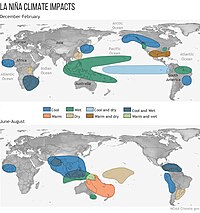
Photo from wikipedia
The asymmetry of mixed layer salinity (MLS) anomalies in response to El Niño and La Niña events in the tropical Pacific is examined for the first time based on Argo… Click to show full abstract
The asymmetry of mixed layer salinity (MLS) anomalies in response to El Niño and La Niña events in the tropical Pacific is examined for the first time based on Argo observations and Estimating the Circulation and Climate of the Ocean simulation. The difference of MLS anomalies between El Niño and La Niña shows a dipole structure, with El Niño featuring strong negative salinity anomalies east of 160°E while La Niña shows remarkable positive salinity anomalies west of 160°E. A salinity budget analysis suggests that nonlinear zonal advection plays a dominant role in generating the asymmetric MLS structure. This dipole MLS structure acts to generate a dipole structure of barrier layer thickness and thus likely plays an important role in the development of El Niño–Southern Oscillation asymmetries in sea surface temperature.
Journal Title: Geophysical Research Letters
Year Published: 2019
Link to full text (if available)
Share on Social Media: Sign Up to like & get
recommendations!